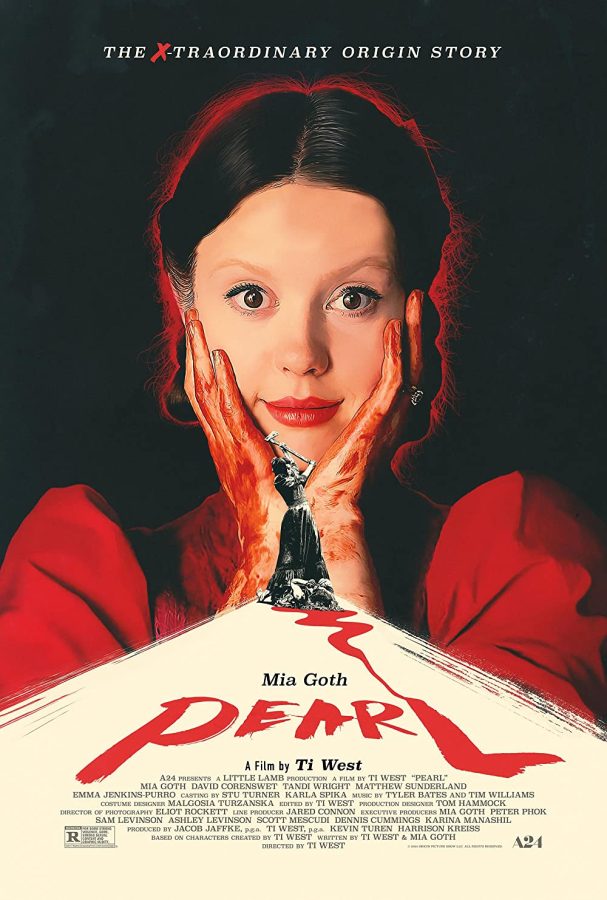For the past decade, the horror landscape has been defined by deeply serious stories of grief and trauma. In an attempt to elevate the genre beyond its usual lurid trappings, filmmakers like Ari Aster and Alex Garland have injected their stories with countless metaphors. Ti West’s “Pearl” has no such concern. A prequel to “X,”, it follows the titular murderous farm native, Pearl, and her desire to escape her beatnik town and become a star.
Set in 1918 amidst the Spanish Influenza pandemic, Pearl anxiously awaits her husband’s return from World War I, quickly losing faith in him and his return. Without a husband, she is forced to stay on the family farm with her paralyzed father and virulently pious German mother. There, her mother forbids her from going to the movie theater, talking to any men or doing anything potentially sinful. Pearl’s world is changed when she learns of a dance audition that could take her away from town, and in her mind, to stardom. Throughout all of this, Pearl finds a bizarre solace in killing small animals, then larger animals, and, eventually humans. This desire for murder is only one of her repressed attributes, clawing to get to the surface. The pivotal question in the film is how long she can keep these feelings deep down.
Pearl’s run-in with a classically handsome projectionist helps to ignite another of her severely repressed attributes: her sexuality. The Projectionist,, played by David Corenswet, realizes how much the movies mean to her, and introduces her to a different kind of movie: a taboo pornographic film he sourced while in Europe. Pearl is totally entranced, and we further understand her deep-seated relationship with cinema in every, and any form.
While “X” was a derivative of grimy slashers like “The Texas Chain Saw Massacre,” “Pearl” is styled more like a melodrama from Hollywood’s Golden Age. Bright, almost sickly saturated colors are reminiscent of Technicolor confections like “The Wizard of Oz” and Douglas Sirk’s “All That Heaven Allows.” Pearl’s dream to shed her provincial existence and become a star is straight out of a “Gold Diggers” movie from the 1930s. Mia Goth’s magnetic central performance as Pearl is theatrical and broad, often sliding from cartoonishly innocent to horribly evil in one line. Goth was a co-writer on the film with director Ti West, and their enthusiasm for this character in “X” and “Pearl” is palpable.
Initially, it was shocking how much time is devoted to Pearl roaming about the farm, wistfully lamenting to the farm animals and dreaming of stardom. The film ends up feeling like a parodic character study, something reminiscent of “Taxi Driver” or “American Psycho.” The film sets up a classic story of a small town girl hungry for fame, who also just happens to enjoy killing living things. Goth walks that line with grace, weaving together what could have been two severely mismatched tones.
With a concept so hyper-focused on style and switching up genre conventions, it was a bit of a challenge to stay fully engaged in the story. For the most part, “Pearl” succeeds as a film. But by the midpoint , a good deal of its charm and exoticism has worn off. Once the audience is familiar with its perspective on Hollywood silliness, it’s clearer that the bulk of these characters are one-dimensional.
The greatest strength of classic melodramas, like those of Douglas Sirk, is their universality. Even when ridiculous things happen in those stories, we can relate to the characters’ desire to express their feelings wholeheartedly. In imitations like “Pearl,” the attempt to point out the ridiculousness of melodrama ends up feeling more cynical, and thereby less effective. As a horror movie, “Pearl” delivers some truly disturbing, well-composed imagery, but the character study feels limited.
This is not the end for Ti West and Mia Goth’s collaboration. They already have a third project in the works, a sequel titled “MaXXXine” which follows the survivor of the first film, “X” as she tries to make a name for herself as a porn star in 1980s Los Angeles. Given the stylistic shift between “X” and “Pearl,” there’s no telling where West will go with the next entry in the franchise. Even if they end up feeling thematically thin, each film so far has made for a fun time at the movies, with some undeniably well-crafted visual storytelling.
Thomas Machacz can be reached at [email protected].




















